You can drive it with the power limit up to the maximum allowed 380 watts, or sit back relaxed in noble modesty. And always with the knowledge that the last watt from the can only leads to more heat and noise, but not really to more gaming performance. And so PNY runs the GeForce RTX 2080 Ti XLR8 factory with 260 watts and lays out the rest of the card accordingly cheaper.
This, of course, did not result in a super-OC card (which no longer exists with the RTX) nor a 1.8-kilo heavy cooling fuel, but a balanced compromise of effort, benefits and, in the end, probably also costs. It's certainly bigger, heavier and visually even more brutal – but not everyone really wants that. There are certainly some things that this card can't do, but you don't pay for it. And that's where she starts to get interesting again.
Unboxing and functionality
At 1045 grams, the card is quite light, which doesn't have to be negative yet, but already gives a glimpse of certain things. With 30.7 cm from the outer edge slot panel to the end of the cooler, it is already quite long, but measures only 10.7 cm from the top edge slot panel to the top edge of the graphics card housing. As a real dual slot card it is only 3.5 cm thick and the 0.5 cm for the backplate must also be taken into account.
Otherwise, the map is visually more of a grey mouse, as PNY has simply saved itself the usual RGB combat illumination and any color combat paints. The black ABS radiator cover with the anthracite-coloured light metal cover in brush look is minimalistic but well-designed. The backplate is pure optics and has no cooling function
PNY delivers the card with two external 8-pin ATX power supply connectors. This card has got a maximum power limit (not to be confused with the Power Target) of 300 watts in the firmware, the standard Power Target is at a reasonable 260 watts.
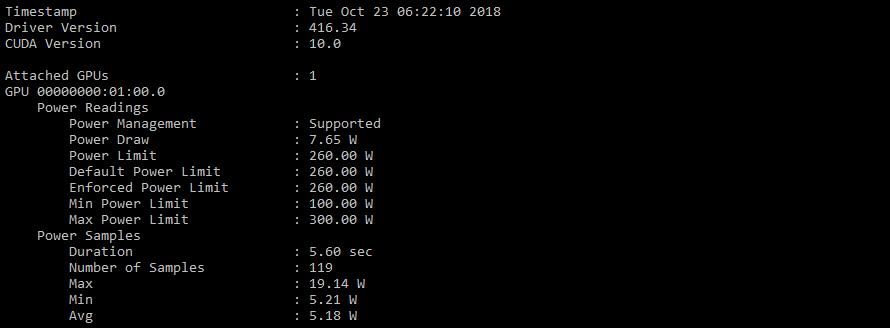
The GPU-Z-Screenshot then tells us the rest of the details:
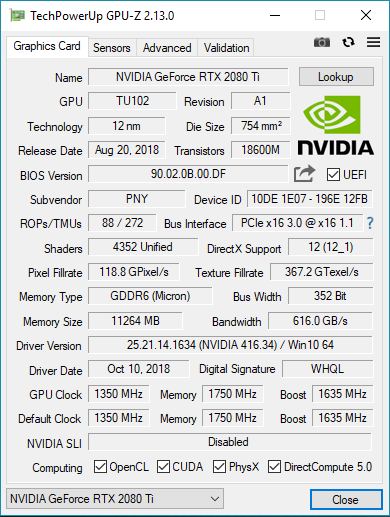
Technical data and comparison maps
At the end of this introduction, the maps of the new generation and those of the old generation in direct tabular comparison:
| Pny GeForce RTX 2080 Ti XLR8 |
Nvidia GeForce RTX 2080 Ti Fe |
Nvidia GeForce RTX 1080 Ti Fe |
Nvidia GeForce RTX 2080 Fe |
Nvidia GeForce RTX 1080 Fe |
|
| Architecture (GPU) |
Turing (TU102) | Turing (TU102) | Pascal (GP102) | Turing (TU104) | Pascal (GP104) |
| CUDA Cores |
4352 | 4352 | 3584 | 2944 | 2560 |
| Peak FP32 Compute |
14.2 TFLOPS |
14.2 TFLOPS | 11.3 TFLOPS | 10.6 TFLOPS | 8.9 TFLOPS |
| Tensor-Cores |
544 | 544 | No | 368 | No |
| RT-Cores |
68 | 68 | No | 48 | No |
| Texture Units |
272 | 272 | 224 | 184 | 160 |
| Basic clock |
1350 | 1350 MHz | 1480 MHz | 1515 MHz | 1607 MHz |
| Boost clock |
1635 | 1635 MHz | 1582 MHz | 1800 MHz | 1733 MHz |
| Memory |
11GB GDDR6 | 11GB GDDR6 | 11GB GDDR5X | 8GB GDDR6 | 8GB GDDRX5 |
| Storage bus |
352-bit | 352-bit | 352-bit | 256-bit | 256-bit |
| Memory bandwidth |
616 GB/s | 616 GB/s | 484 GB/s | 448 GB/s | 320 GB/s |
| Rops |
88 | 88 | 88 | 64 | 64 |
| L2 Cache |
5.5MB | 5.5MB | 2.75MB | 4MB | 2MB |
| Tdp |
300w | 260W | 250w | 225W | 180w |
| Transistors |
18.6 billion | 18.6 billion | 12 billion | 13.6 billion | 7.2 billion |
| Chip size |
754 mm2 | 754 mm2 | 471 mm2 | 545 mm2 | 314 mm2 |
| SLI Support |
Yes (x8 NVLink, x2) | Yes (x8 NVLink, x2) | Yes (MIO) | Yes (x8 NVLink) | Yes (MIO) |
Test system and measurement methods
We have already described the new test system and the methodology in detail in the basic article "How We Test Graphics Cards, as of February 2017" and therefore refer to this detailed basis for simplicity. Description. So if you want to read everything again, you are welcome to do so. However, we have again improved CPU and cooling to largely exclude possible CPU bottlenecks for this fast card.
If you are interested, the summary in table form quickly provides a brief overview:
| Test systems and measuring rooms | |
|---|---|
| Hardware: |
Intel Core i7-6900K -4.5GHz MSI X99S XPower Gaming Titanium G.Skill TridentZ DDR4 3600 1x 1 TByte Toshiba OCZ RD400 (M.2, System SSD) 2x 960 GByte Toshiba OCZ TR150 (Storage, Images) Be Quiet Dark Power Pro 11, 850-watt power supply |
| Cooling: |
Alphacool Ice Block XPX 5x Be Quiet! Silent Wings 3 PWM (Closed Case Simulation) Thermal Grizzly Kryonaut (for cooler change) |
| Housing: |
Lian Li PC-T70 with expansion kit and modifications Modes: Open Benchtable, Closed Case |
| Monitor: | Eizo EV3237-BK |
| Power consumption: |
non-contact DC measurement on the PCIe slot (Riser-Card) non-contact DC measurement on the external PCIe power supply Direct voltage measurement on the respective feeders and on the power supply 2x Rohde & Schwarz HMO 3054, 500 MHz multi-channel oscillograph with memory function 4x Rohde & Schwarz HZO50, current togor adapter (1 mA to 30 A, 100 KHz, DC) 4x Rohde & Schwarz HZ355, touch divider (10:1, 500 MHz) 1x Rohde & Schwarz HMC 8012, digital multimeter with storage function |
| Thermography: |
Optris PI640, infrared camera PI Connect evaluation software with profiles |
| Acoustics: |
NTI Audio M2211 (with calibration file) Steinberg UR12 (with phantom power for the microphones) Creative X7, Smaart v.7 own low-reflection measuring room, 3.5 x 1.8 x 2.2 m (LxTxH) Axial measurements, perpendicular to the center of the sound source(s), measuring distance 50 cm Noise in dBA (Slow) as RTA measurement Frequency spectrum as a graph |
| Operating system | Windows 10 Pro (1803, all updates) |














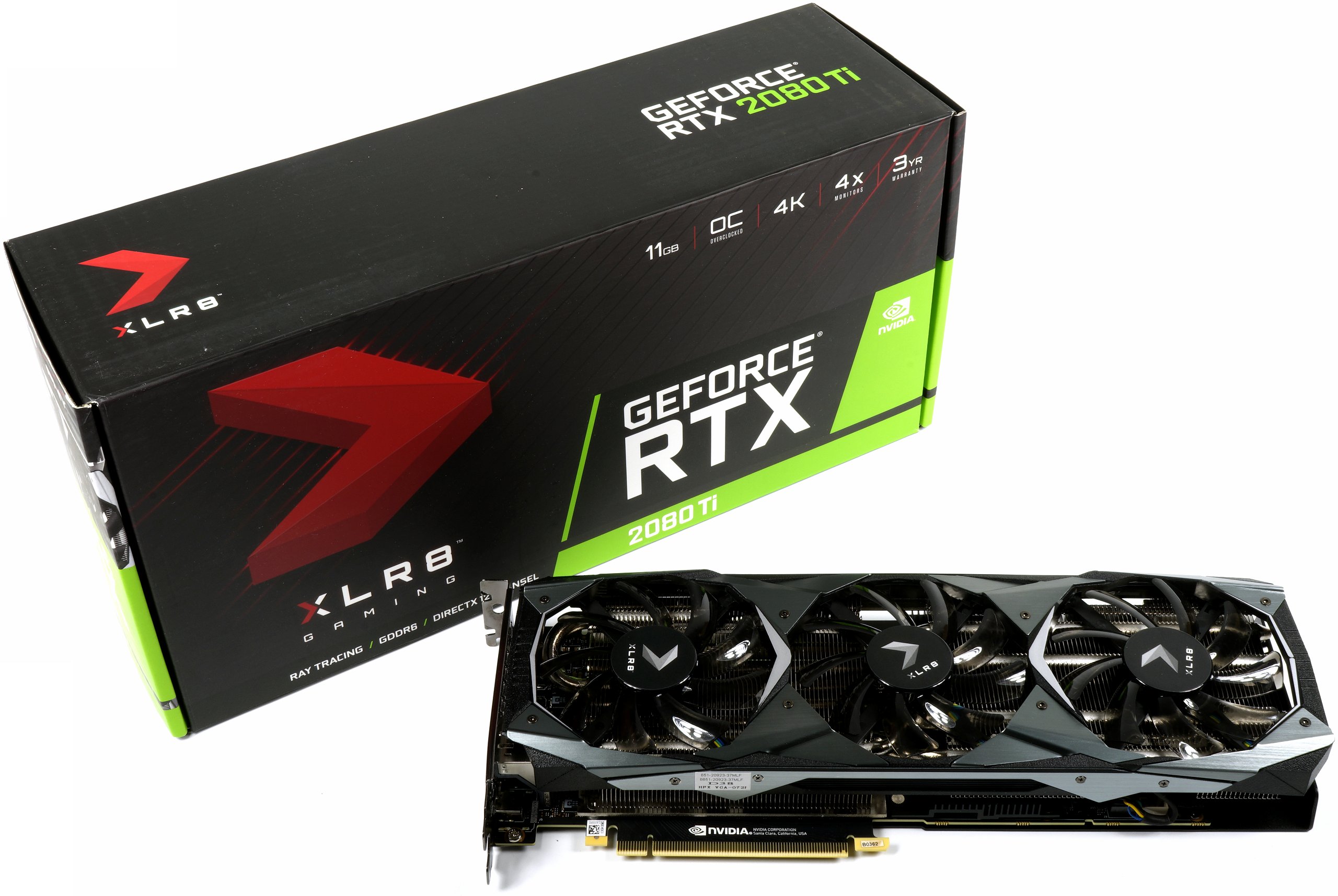









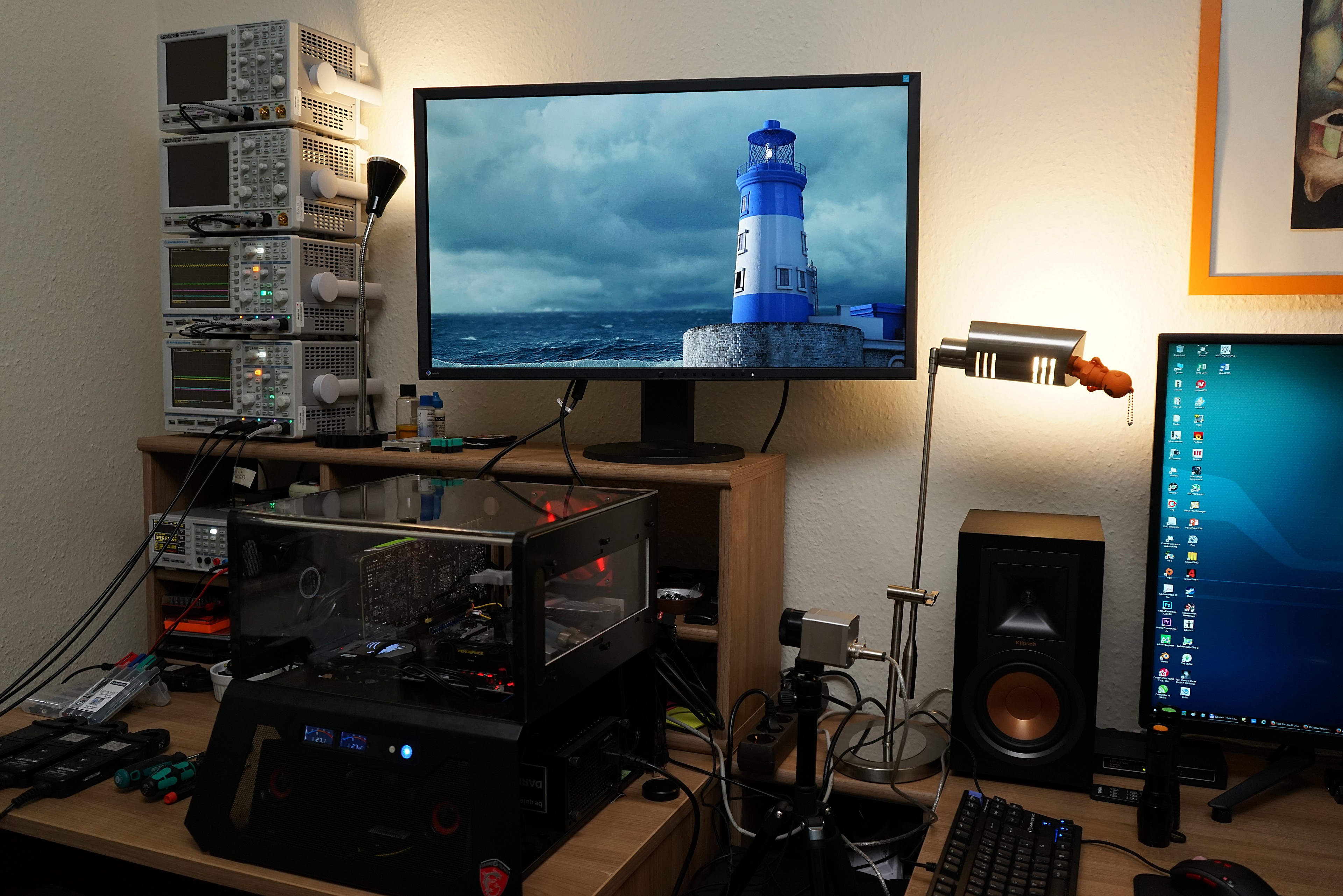



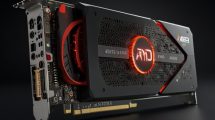
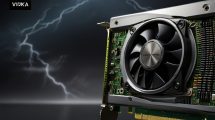













Kommentieren